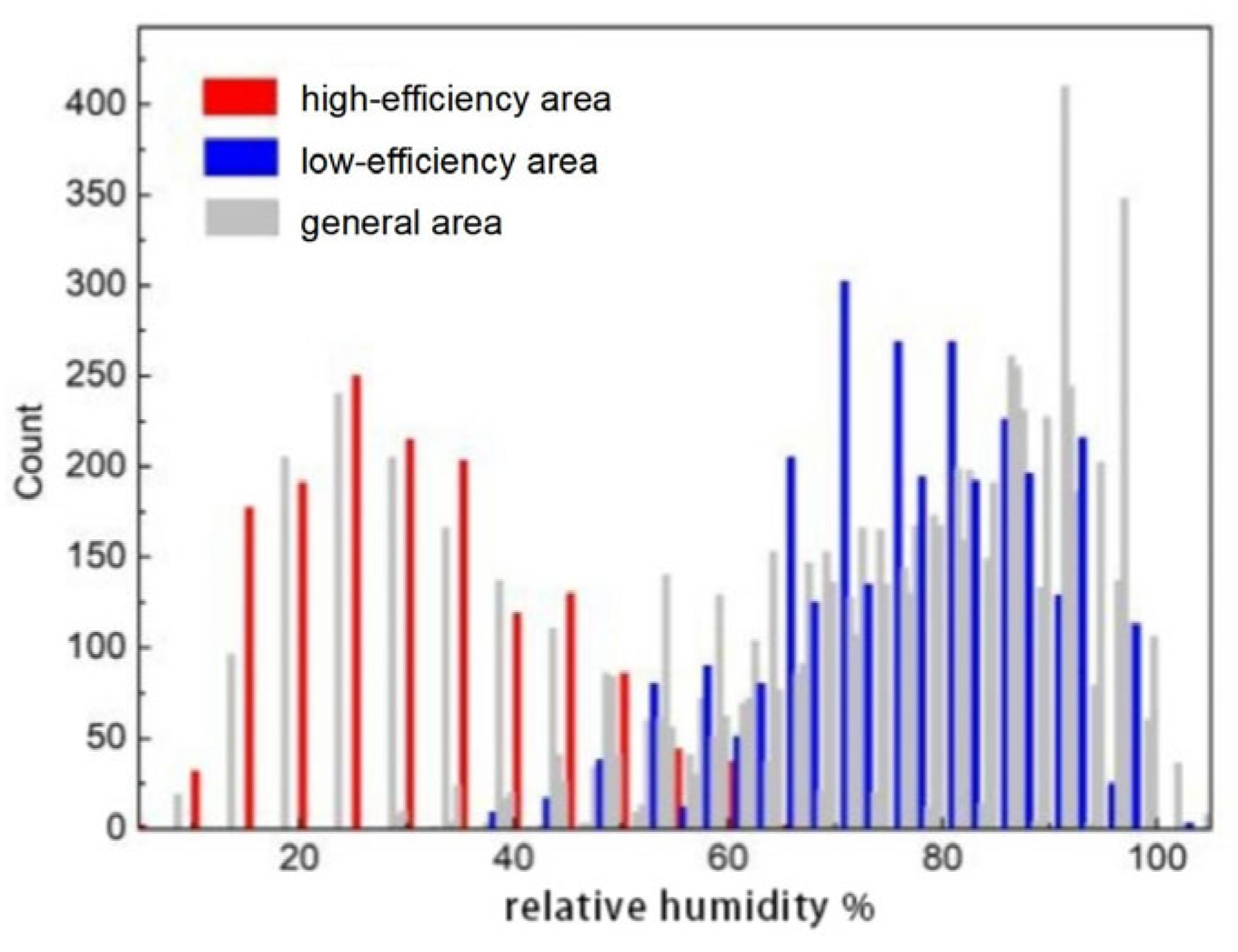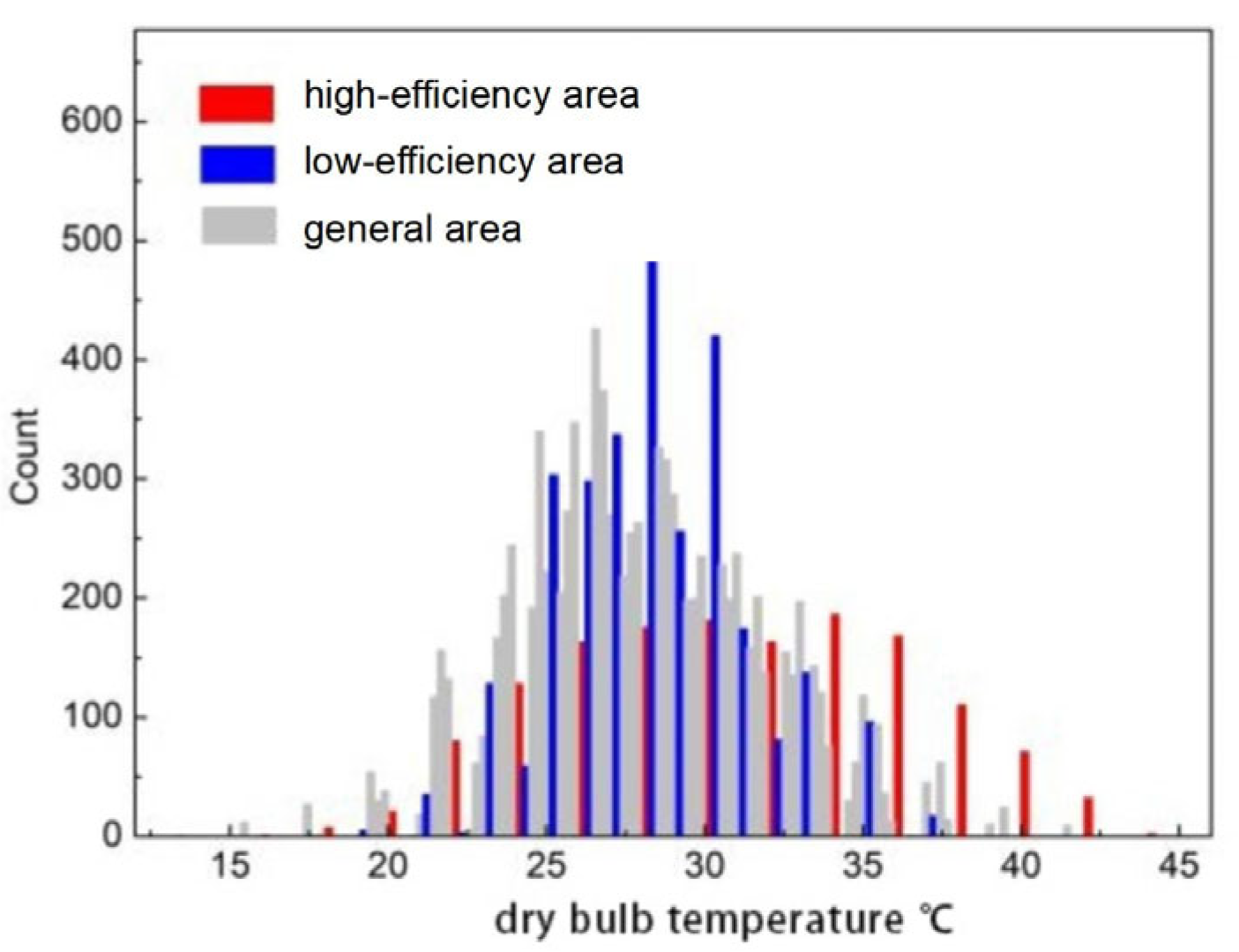Simulation Study on the Effects of Relative Humidity (RH) on Long-Wave Radiative Heat Gain in Residential Buildings
Abstract
1. Introduction
2. Research Methods
2.1. Calculation of Long-Wave Radiation
2.2. Sky Radiation Model
2.3. Selection of Typical Cities
2.4. Simulation Settings
3. Calculation Results
3.1. Building Long-Wave Radiation
3.2. Influence of Long-Wave Radiation Heat Transfer
3.3. Applicable Weather Conditions
4. Conclusions
Author Contributions
Funding
Data Availability Statement
Conflicts of Interest
References
- Building Energy Conservation Research Center, Tsinghua University. China Building Energy Conservation Annual Development Research Report; China State Construction Industry Press: Beijing, China, 2019; pp. 3–15. [Google Scholar]
- Zhao, Z. A Brief Analysis of Building Energy Saving Measures and Renewable Energy Utilization. Ind. Build. 2013, 43, 94–96. [Google Scholar]
- Xie, S.; Chu, D. Thinking and Methods of sustainable Architectural Design. Ind. Build. 2019, 49, 54–59. [Google Scholar]
- Xie, X.; Luo, Z.; Grimmond, S.; Sun, T.; Morrison, W. Impact of inter-building longwave radiative exchanges on building energy performance and indoor overheating. Build. Environ. 2022, 209, 108628. [Google Scholar] [CrossRef]
- Wang, T.; Shi, J.; Ma, Y.; Letu, H.; Li, X. All-sky longwave downward radiation from satellite measurements: General parameterizations based on LST, column water vapor and cloud top temperature. Isprs J. Photogramm. Remote Sens. 2020, 161, 52–60. [Google Scholar] [CrossRef]
- Li, D.; Wang, T.; Zheng, X.; Zhang, P.; Zheng, L.; Leng, W.; Du, Y.; Chen, L.; Zhang, W. Multi-Dimensional matrix MAPping (MDMAP): A new algorithm framework to derive top-of-atmosphere outgoing longwave radiation from space. Remote Sens. Environ. 2024, 304, 114031. [Google Scholar] [CrossRef]
- Xu, J.; Liang, S.; Ma, H.; He, T.; Zhang, Y.; Zhang, G. A daily 5-km all-sky sea-surface longwave radiation product based on statistically modified deep neural network and spatiotemporal analysis for 1981–2018. Remote Sens. Environ. 2023, 290, 113550. [Google Scholar] [CrossRef]
- Li, M.; Peterson, H.B.; Coimbra, C.F.M. Radiative cooling resource maps for the contiguous United States. J. Renew. Sustain. Energy 2019, 11, 036501. [Google Scholar] [CrossRef]
- Zhu, Y.; Qian, H.; Yang, R.; Zhao, D. Radiative sky cooling potential maps of China based on atmospheric spectral emissivity. Sol. Energy 2021, 218, 195–210. [Google Scholar] [CrossRef]
- Chen, J.; Lu, L.; Gong, Q. A new study on passive radiative sky cooling resource maps of China. Energy Convers. Manag. 2021, 237, 114132. [Google Scholar] [CrossRef]
- Brunt, D. Notes on radiation in the atmosphere. I. Q. J. R. Meteorol. Soc. 1932, 58, 389–420. [Google Scholar] [CrossRef]
- Brutsaert, W. On a derivable formula for long-wave radiation from clear skies. Water Resour. Res. 1975, 11, 742–744. [Google Scholar] [CrossRef]
- Maghrabi, A.; Clay, R. Nocturnal infrared clear sky temperatures correlated with screen temperatures and GPS-derived PWV in southern Australia. Energy Convers. Manag. 2011, 52, 2925–2936. [Google Scholar] [CrossRef]
- Bilbao, J.; De Miguel, A.H. Estimation of Daylight Downward Longwave Atmospheric Irradiance under Clear-Sky and All-Sky Conditions. J. Appl. Meteorol. Clim. 2007, 46, 878–889. [Google Scholar] [CrossRef]
- Li, M.; Jiang, Y.; Coimbra, C.F.M. On the determination of atmospheric longwave irradiance under all-sky conditions. Sol. Energy 2017, 144, 40–48. [Google Scholar] [CrossRef]
- Chen, Q. Selected Works of Chen Qigao on Architectural Physics; China State Construction Industry Press: Beijing, China, 2004; pp. 452–455. [Google Scholar]
- Evangelisti, L.; Guattari, C.; Asdrubali, F. On the Sky Temperature Models and Their Influence on Buildings Energy Performance: A Critical Review. Energy Build. 2019, 183, 607–625. [Google Scholar] [CrossRef]
- ASHRAE Standard 169-2006; Weather Data for Building Design Standards. American Society of Heating, Refrigerating and Air-Conditioning Engineers: Atlanta, GA, USA, 2006.
- Prata, A.J. A new long-wave formula for estimating downward clear-sky radiation at the surface. Quart. J. Roy. Meteorol. Soc. 1996, 122, 1127–1151. [Google Scholar]
- Dilley, A.C.; O’Brien, D.M. Estimating downward clear sky long-wave irradiance at the surface from screen temperature and precipitable water. Quart. J. Roy. Meteorol. Soc. 1998, 124, 1391–1401. [Google Scholar]
- Marthews, T.R.; Malhi, Y.; Iwata, H. Calculating downward longwave radiation under clear and cloudy conditions over a tropical lowland forest site: An evaluation of model schemes for hourly data. Theor. Appl. Clim. 2011, 107, 461–477. [Google Scholar] [CrossRef]
- Crawford, T.M.; Duchon, C.E. An improved parameterization for estimating effective atmospheric emissivity for use in calculating daytime downwelling long-wave radiation. J. Appl. Meteorol. 1999, 38, 474–480. [Google Scholar] [CrossRef]
- Konzelmann, T.; Van de Wal, R.S.W.; Greuell, W.; Bintanja, R.; Henneken, E.A.C.; Abe-Ouchi, A. Parameterization of global and longwave incoming radiation for the Greenland Ice Sheet. Glob. Planet. Chang. 1994, 9, 143–164. [Google Scholar] [CrossRef]
- Sridhar, V.; Elliott, R.L. On the development of a simple downwelling long-wave radiation scheme. Agric. Meteorol. 2002, 112, 237–243. [Google Scholar] [CrossRef]
- Iziomon, M.G.; Mayer, H.; Matzarakis, A. Downward atmospheric longwave irradiance under clear and cloudy skies: Measurement and parameterization. J. Atmos. Sol.-Terr. Phy 2003, 65, 1107–1116. [Google Scholar] [CrossRef]
- Duarte, H.F.; Dias, N.L.; Maggiotto, S.R. Assessing daytime downward long-wave radiation estimates for clear and cloudy skies in Southern Brazil. Agric. Meteorol. 2006, 139, 171–181. [Google Scholar] [CrossRef]
- Lhomme, J.P.; Vacher, J.J.; Rocheteau, A. Estimating downward long-wave radiation on the Andean Altiplano. Agric. For. Meteorol. 2007, 145, 139–148. [Google Scholar] [CrossRef]
- GB 50176-2016; Code for Thermal Design of Civil Buildings. Ministry of Housing and Urban-Rural Development of the People’s Republic of China: Beijing, China, 2016.
- Zhang, H. Research on Time Domain Division of Climate Adaptability for Building Energy Efficiency; Chongqing University: Chongqing, China, 2009. [Google Scholar]








| Cooling Level | Representative City | CDD26 (°C·d) Degree Days for Air Conditioning | Thermal Partition |
|---|---|---|---|
| level 1 | Turpan | 579 | Cold regions |
| East | 530 | Hot summer and warm winter area | |
| Haikou | 427 | Hot summer and warm winter area | |
| level 2 | Guangzhou | 313 | Hot summer and cold winter area |
| Wuhan | 283 | Hot summer and cold winter area | |
| Chongqing | 217 | Hot summer and cold winter area | |
| level 3 | Karamay | 196 | Frigid regions |
| Xi’an | 153 | Cold regions | |
| Beijing | 94 | Cold regions |
| Climate Zone | Typical City | Air-Conditioning Period |
|---|---|---|
| Frigid regions | Harbin | None |
| Cold regions | Beijing | 20 June to 3 August |
| Hot summer and cold winter area | Changsha | 25 June to 23 August |
| Hot summer and warm winter area | Guangzhou | 26 May to 22 September |
| Temperate area | Kunming | None |
| Name | Structure Level (From Outside to Inside) (mm) | Thermal Conductivity |
|---|---|---|
| Exterior wall | 10 thick facing brick; 30 thick EPS board; 100 thick reinforced concrete; 10 thick gypsum board | 0.58 |
| Roof | 10 thick stone panels; 5 thick asphalt layers; 150 thick cast concrete; 80 thick fiberglass mats; 100 thick hollow blocks; 10 thick ceiling slabs | 0.38 |
| Ground | 25 thick laminated board; 60 thick foam polystyrene insulation board; 100 thick reinforced concrete; 250 thick facing brick; 750 thick clay; | 0.24 |
| Floor | 60 mm paving tiles; 120 mm concrete floor slabs | 2.80 |
| External window (with frame) | Low-e hollow double window | 2.16 |
| Exterior doors | Wooden door | 2.19 |
| Partition | 13 thick cement mortar; 105 thick non-load-bearing hollow brick; 13 thick cement mortar | 1.69 |
| City | Load Difference | Minimum Value | Maximum Value | Gain Ratio | Gain Difference | Gain Minimum | Gain Maximum |
|---|---|---|---|---|---|---|---|
| Turpan | 2126.398 | 30,962.782 | 33,089.18 | 0.15201 | 2129 | 11,875.7 | 14,004.495 |
| Dongfang | 965.42893 | 18,801.574 | 19,767.00293 | 0.13576 | 966 | 6147.436 | 7113.118 |
| Haikou | 1470.00077 | 17,145.29923 | 18,615.3 | 0.20578 | 1479 | 5709.78 | 7189.195 |
| Guangzhou | 1755.03814 | 14,635.725 | 16,390.76314 | 0.27186 | 1782 | 4773.4 | 6555.64 |
| Wuhan | 1506.636 | 19,471.69 | 20,978.326 | 0.18212 | 1579 | 7092.877 | 8672.26 |
| Chongqing | 401.63973 | 12,751.296 | 13,152.93573 | 0.11468 | 442 | 3409.866 | 3851.566 |
| Karamay | 1455.25 | 14,635.671 | 16,090.921 | 0.26655 | 1545 | 4252.073 | 5797.382 |
| Xi’an | 1501.984 | 11,889.37 | 13,391.354 | 0.32163 | 1616 | 3408.616 | 5024.692 |
| Beijing | 1493.81 | 9313.584 | 10,807.394 | 0.38408 | 1570 | 2518.46 | 4088.958 |
Disclaimer/Publisher’s Note: The statements, opinions and data contained in all publications are solely those of the individual author(s) and contributor(s) and not of MDPI and/or the editor(s). MDPI and/or the editor(s) disclaim responsibility for any injury to people or property resulting from any ideas, methods, instructions or products referred to in the content. |
© 2024 by the authors. Licensee MDPI, Basel, Switzerland. This article is an open access article distributed under the terms and conditions of the Creative Commons Attribution (CC BY) license (https://creativecommons.org/licenses/by/4.0/).
Share and Cite
Chen, J.; Xue, F.; Jin, X.; Lau, S.S.Y.; Fan, Y. Simulation Study on the Effects of Relative Humidity (RH) on Long-Wave Radiative Heat Gain in Residential Buildings. Buildings 2024, 14, 3724. https://doi.org/10.3390/buildings14123724
Chen J, Xue F, Jin X, Lau SSY, Fan Y. Simulation Study on the Effects of Relative Humidity (RH) on Long-Wave Radiative Heat Gain in Residential Buildings. Buildings. 2024; 14(12):3724. https://doi.org/10.3390/buildings14123724
Chicago/Turabian StyleChen, Jie, Fei Xue, Xiaoxue Jin, Stephen Siu Yu Lau, and Yue Fan. 2024. "Simulation Study on the Effects of Relative Humidity (RH) on Long-Wave Radiative Heat Gain in Residential Buildings" Buildings 14, no. 12: 3724. https://doi.org/10.3390/buildings14123724
APA StyleChen, J., Xue, F., Jin, X., Lau, S. S. Y., & Fan, Y. (2024). Simulation Study on the Effects of Relative Humidity (RH) on Long-Wave Radiative Heat Gain in Residential Buildings. Buildings, 14(12), 3724. https://doi.org/10.3390/buildings14123724










